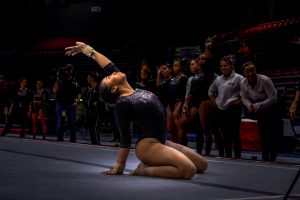Homecoming different from yesteryears
October 24, 1988
Homecoming at NIU has slowly evolved from its early beginnings in 1900, when it was nothing more than an organization entitled “The Alumni Association,” to a week-long celebration of special activities.
The Alumni Association first was designed to send a group of students to meet all incoming trains on one weekend in October. The students would greet and pick up the “old grads” of the Northern Illinois State Normal School (which was NIU’s original name). Alumni would come to town for the weekend to attend business meetings, receptions, a football game and a banquet.
The football game, organized in 1903, was a contest between the alumni and the presiding varsity team. The occasion was officially named “Homecoming” in 1906 and an official date was set for the meeting, game and banquet on the second Saturday in October.
The tradition of the alumni football game continued annually until 1913, when it stopped because the alumni were not always in adequate physical condition to participate.
The annual banquets that followed the games were the highlight of the weekend. The dinners were greatly anticipated as a time for the “comebackers” to join the faculty and NISNS President John Cook in the school’s library for an evening of laughter and tears of remembrance.
Serving as toastmaster, Cook read letters from alumni unable to attend and recited his annual alumni poem:
“From near and far the loving mother calls
Her faithful children to her hallowed halls.
Her grateful towers, ivy-grown and gray,
Voiceless welcome on this joyous day.”
Alumni and faculty followed Cook’s presentation with several toasts and recollections of their days on campus.
The climax of the occasion occurred just as the alumni were about to leave. Cook would stand up and say, “Stand by, stand by, stand by.”
The phrase had significant meaning to the alumni because it was used as an encouraging and inspirational slogan for early NISNS students. The saying was used by those who wanted improvement in game attendance, participation in student organizations, homework completion and loyalty to their school.
In the early 1920s, an informal dance was added to the Homecoming agenda. The dance eventually edged out the tradition of the banquet and by the 1940s, the banquet had been changed to an afternoon tea, open house or a buffet dinner.
The Homecoming parade also was initiated in the early ‘20s. The parade was led by the Varsity Club and followed by organizations, floats and clowns.
In 1947, NIU’s first Homecoming Queen was crowned. The queen, however, did not have a king by her side until three years later at the first coronation dance.
During the ’40s and ‘50s, NIU went through a large period of growth, which was reflected in the Homecoming celebrations of those years. The celebrations often included dedications of new buildings or ground-breaking ceremonies.
By 1961, Homecoming had grown to a week-long celebration, similar to what is presently held. Classes were cancelled on the Friday of Homecoming week so students could work on floats and house decorations.






